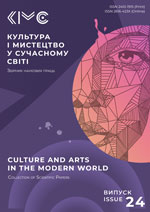Signs of the Uniqueness of the Ukrainian Printed Book in the Context of the Global Digitalisation of Art
DOI:
https://doi.org/10.31866/2410-1915.24.2023.287703Keywords:
printed book, e-book, interactive book, multimedia book, art book, book design, digital formatAbstract
The aim of the article is to explore the features of the uniqueness of a classic printed book as a valuable source of art studies analysis against the backdrop of dynamic transformations in Ukrainian book design. The article seeks to determine the prospects for its development as an artistic and project form, and ways to preserve the relevant design traditions. Results. The perception of traditional printed books in Ukraine today has changed in the context of the global digitisation of art. In this regard, the following opposing positions of scholars are highlighted: some predict a new phase of life for printed books, which involves the transformation of their socio-cultural role and the acquisition of different artistic content, while others underestimate the potential of traditional paper publications compared to innovative electronic formats. However, it is worth noting that the modern Ukrainian printed book has exclusive visual and aesthetic characteristics, demonstrating a unique synthesis of subject-spatial and artistic-design solutions. These characteristics include the long-term preservation of book design traditions, presentation of the designer's own artistic style (illustrator), tactile features (paper type, frame type, etc.), as well as the consistency of the layout at all levels of its implementation. The article proves this fact by comparing the design features of classic book editions with their alternative forms: electronic (multimedia) and interactive editions, as well as art books. The scientific novelty of the article consists in a comprehensive examination of the coexistence of various book forms on the modern domestic book market, their mutual influence, and the formulation of prospects for the development of the Ukrainian traditional printed books based on theoretical and empirical research of relevant sources, which was carried out for the first time. Conclusions. The article demonstrates that the highest potential of a traditional printed book lies in its highly differentiated design, unique artistic, genre and functional characteristics. The guarantee of the future of such publications is the mandatory presence of artistic and creative components in the book ensemble, as well as a genre-functional variable component.
References
Karakoz, O. O. (2019). Tradytsiina knyha – fenomen suchasnoho sotsiokulturnoho prostoru [Traditional book – phenomenon of modern socio-cultural space]. Library science. Record studies. Informology, 3, 93–100. https://doi.org/10.32461/2409-9805.3.2019.187984 [in Ukrainian].
Lystvak, H. (2011). Rysy "knyhy khudozhnyka" v suchasnykh ukrainskykh vydanniakh [Artist’s book features in contemporary Ukrainian editions]. Printing and Publishing, 4(56), 39–44 [in Ukrainian].
Oliinyk, V. A. (2022). Innovatsii vizualnoi movy suchasnoho ukrainskoho knyzhkovoho dyzainu [Innovations of the visual language of modern Ukrainian book design]. In Modern Aspects of Science (Vol. 20, pp. 529–539). International Economic Institute s.r.o. [in Ukrainian].
Pozharytska, O. O. (2022). Zroby svii vybir: Knyhy-ihry yak predtechi kompiuternoi literatury [Make your choice: Gamebooks as digital literature predecessors]. Lviv Philological Journal, 11, 172–181. https://doi.org/10.32447/2663-340X-2022-11.26 [in Ukrainian].
Rodyhin, K. M. (2016). Fenomen knyhy v konteksti posthutenberhivskoi epokhy ta Novoho Serednovichchia [The phenomenon of a book in the context of post-gutenberg era and the New Middle Ages]. Visnyk Donetskoho natsionalnoho universytetu, 1, 203–213 [in Ukrainian].
Rudenko, O. (2020). Mystetstvo knyhy yak estetychne dzherelo dukhovnoi kultury narodu [Book art: An aesthetic source for the spiritual culture of the people]. Newsletter Transcarpathian Academy of Arts, 14, 98–107 [in Ukrainian].
Skliarenko, N., & Bukharina, I. (2022). Imersyvni tekhnolohii u dyzaini knyzhkovoi produktsii: Pryntsypy proiektuvannia [Immersive technologies in book design: Design principles]. Demiurge: Ideas, Technologies, Perspectives of Design, 5(2), 270–282. https://doi.org/10.31866/2617-7951.5.2.2022.266919 [in Ukrainian].
Skliarenko, N., & Kolosnichenko, M. (2022). Dynamichne proiektuvannia polihrafichnoi produktsii: Sposoby transformatsii khudozhnoho obrazu [Dynamic design of printing products: Methods of artistic image transformation]. In Hrafichnyi dyzain v informatsiinomu ta vizualnomu prostori [Graphic design in the information and visual space] (pp. 35–58). Kyiv National University of Technologies and Design. https://er.knutd.edu.ua/bitstream/123456789/19964/1/GDIVP_mono_2022_P035-058.pdf [in Ukrainian].
Teremko, V. (2011). Stratehichni vyklyky drukovanii kulturi v elektronnu eru [Strategic challenges to print culture in the electronic era]. Bulletin of the Book Chamber, 5, 14–18 [in Ukrainian].
Teremko, V. (2012). Avtor u stratehichnii systemi vydavnytstva [Author in strategic system of publishing]. Printing and Publishing, 1(57), 16–29 [in Ukrainian].
Vahanova, K. (2020, December 17). Elektronni knyhy VS drukovani [E-books VS print]. Ya – zhurnalist. https://ij.ogo.ua/ya-zhurnalist/elektronni-knigi-vs-drukovani/ [in Ukrainian].
Downloads
Published
How to Cite
Issue
Section
License

This work is licensed under a Creative Commons Attribution 4.0 International License.
Authors who publish in this journal agree to the following terms:
1) The authors reserve the right to the authorship of their work and transfer to the journal the right to first publish this work under the terms of the Creative Commons Attribution License, which allows others to freely distribute the published work with a mandatory reference to the authors of the original work and the first publication of the work in this journal.
2) The authors have the right to enter into independent additional agreements for non-exclusive distribution of the work in the form in which it was published by this journal (for example, to place the work in the electronic repository of the institution or to publish it as part of a monograph), provided that the reference to the first publication of the work in this journal is maintained.
3) The journal's policy allows and encourages authors to post their manuscripts on the Internet (for example, in institutional repositories or on personal websites) both before submitting the manuscript to the editorial board and during its editorial processing, as this contributes to the emergence of a productive scientific discussion and has a positive effect on the efficiency and dynamics of citation of published work (see The Effect of Open Access).






